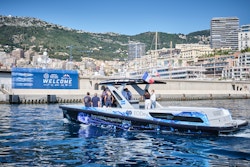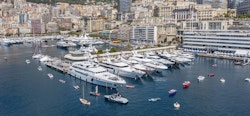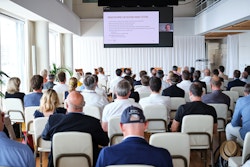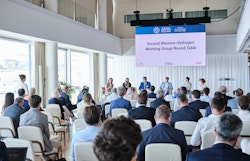Hydrogen, the key to clean yachting
From 6-10 July 2021, Yacht Club de Monaco morphed into an academic and entrepreneurial crossroads for discussions, a laboratory of experiments and an incubator of tomorrow’s renewable energy technologies for the 8th Monaco Energy Boat Challenge. A unique event to showcase the latest sustainable propulsion systems, it was organized in partnership with the International Powerboating Federation (UIM) and Prince Albert II of Monaco Foundation, with renewed support from EODev who provided the technical assistance and participated in the Jury presided by EODev's own CEO, Jérémie Lagarrigue.

In total 32 teams in three classes (17 nationalities) and 20+ exhibitors gathered under the attentive eye of HSH Prince Albert II, President of the Yacht Club de Monaco, and well-known figures such as the explorer Mike Horn and Jean Todt, President of the FIA (Fédération Internationale de l’Automobile), to push their sporting and intellectual resources to the limit in a bid to win one of many prizes awarded the evening of Saturday 10th July. All week, Quai Louis II buzzed with activity, ashore and at sea, generated by a host of initiatives and innovations, complemented by round tables and a conference, Tech Talks and an exhibition ashore, whose focal points of discussion were on yachting, boating and shipping issues in the quest to find sustainable resource-efficient solutions that respect the environment. Amongst these, hydrogen was clearly the "talk of the town", as seven of the teams taking part in the Challenge used it as their primary source of energy.

L'hydrogène au cœur des débats
Two conferences of back-to-back talks and discussions were held Thursday 8th and Friday 9th in the YCM’s Ballroom to work on energy transition, alternative solutions and sustainability initiatives in yachting, with a particular focus on hydrogen the Friday morning for the second Monaco Hydrogen Working Group Round Table. This followed a first meeting held in 2019 by the Monaco Energy Transition Mission, Prince Albert II of Monaco Foundation and Yacht Club de Monaco.
Around a hundred participants attended in person (in compliance with health restrictions) and as many online, with both these days clearly demonstrating that technology developments aimed at “decarbonizing” the maritime sector, yachting included, have the wind in their sails. As well as grants and other funding via institutions (France’s recovery plan, grants, project finance, etc.), R&D and initiatives in the last few years, such as the work being done at universities and companies participating in the Monaco Energy Boat Challenge, are transforming in a practical, pragmatic way the understanding of potential resolutions to environmental issues and how resources are used, from an energy and materials point of view. Above all, private investment is growing, a sign that the economic paradigm linked to the energy and ecological transition is changing.
A fertile ground for carbon-free future
The talks and discussions that took place on Thursday 8th to reflected on initiatives and solutions to decarbonize recreational boats. Twelve speakers took turns at the podium during a day divided into four sessions: current energy mix and alternative fuels; propulsion solutions; new materials; and vessel Lifecycle Analysis initiatives to give a panoramic, technical and succinct view of the issues.

The day started with a keynote speech by Bastien Bornand, energy engineer in the EODev design office Energy Designer, giving a very detailed analysis of the entire spectrum of energy and fuel solutions for vessel propulsion (download presentation here). His scientific analysis put the topic into perspective highlighting the fact that to date there is no universal solution, and will not be one tomorrow, as the majority of answers lie in how technologies evolve in the years to come – it will be talked about later for hydrogen – and above all how usage profiles fit the appropriate energy mix.
Focusing on the environmental impacts of CO₂, NOx, SOx and particulate emissions, without taking into account the economic aspect, Bastien Bornand explained for example how “grey” hydrogen, produced partly from fossil fuels, is actually worse for the planet than using conventional fuels. He also highlighted the relevance of using intermittent renewable sources, solar in particular, in combination with storage solutions such as batteries or hydrogen, as long as they are “green”, in other words produced from renewable sources such as wind power or biomass – when biomass can be used without harming the environment. He also detailed why bio-fuels and synthetic fuels are valid short-term solutions to significantly reduce CO₂ emissions, but are not a panacea and will not in his view provide a satisfactory response to energy needs as a whole.
The next session focused on propulsion system development. From optimized Zenoro diesel generators to the strategy of Cummins, the world’s leading diesel engine producer which is now developing fuel cell and hydrogen based solutions, everyone recognizes that yachting’s future is “electric”, especially hybrid technology combining batteries and hydrogen whatever its storage form.
Taking a real life case study, Stéphane Jardin, EODev's Commercial Director, demonstrated how establishing the usage profile of a yacht enabled EODev to calculate an intelligent optimized hybrid system combining the advantages of batteries for instant power with hydrogen fuel cells to increase a boat’s autonomy (download presentation here). The message was clear: when battery usage is limited by weight, volume and price to obtain the necessary power, recourse to hydrogen makes it possible to respond to bulk-volume issues, even with gas storage at only 350 bars, and in reality is more accessible.
Above all, given the presence of Hynova Yachts at the Monaco Energy Boat Challenge, he explained that this solution was already available and could now replace all-electric, even diesel-electric hybrids – at least on average-sized yachts to start with, while hydrogen storage options and power needs did not yet allow superyachts to be equipped satisfactorily with this solution for propulsion, but only for life on board.
This section, placed under the aegis of the Superyacht Eco Association, co-founded by the Yacht Club de Monaco and Credit Suisse, and initiator of the SEA Index (a tool for assessing the carbon impact of superyachts), reminded us that if propulsion is an important factor in determining the environmental impact generated by yachting, it’s not the only one. Indeed, life on board is another major factor to be taken into account, which the SEA Index can do by also evaluating the generator carbon emissions of superyachts over 40m.
After the morning’s discussions on fuel sources and propulsion systems, attention turned in the afternoon to new recyclable or natural composites that can be used in boat building, including for structural elements.
To summarize the day’s conclusions, it can be said that while there is no miracle solution there are a host of propositions linked to mature technological advances that should be adopted, depending on needs and uses. But above all, sectors need to accelerate the move towards ensuring that infrastructure, regulations, political decisions and financial support are in place to support progress and initiatives, rather than the other way round.
Hydrogen station coming soon to Monaco?
In line with the previous day’s conference, the Monaco Hydrogen Working Group met on Friday 9th July for a mini-conference that went way over the allotted time! Instead of a morning it did not finish until 2.00pm, as discussions were so intense and constructive, with many differences of opinion between experts and representatives of institutional bodies, invited to discuss progress on hydrogen in the region and Monaco. It proved a hot topic.

Organized in two round table sessions of about a dozen speakers, it was a chance for the Working Group to give an update on hydrogen deployment in the territories before focusing on concrete applications and how they’d been implemented in the region.
After an introduction by Samy Touati, General Secretary of the Department of Public Works, the Environment and Urban Development, and that by Philippe Mondielli, Science Director at the Prince Albert II of Monaco Foundation, who recalled the importance of such meetings with all players together to progress issues, Bernard d’Alessandri, Yacht Club de Monaco General Secretary and President of Cluster Yachting Monaco, opened the meeting. He explained why it was important the Principality and luxury yacht sector to consider hydrogen in Monaco as a priority in the drive to achieve decarbonization objectives set by the Government.
However, Annabelle Jaeger Seydoux and Virginie Haché-Vincenot, Director and Head of Division respectively of the Monaco Energy Transition Mission, explained that the Principality had initially chosen electrification for the main harbor and was therefore in their view well-equipped to meet the needs of yachts calling into Monaco, even though the main harbor wall that accommodates the cruise ships and megayachts is not. Although the Government was well aware of hydrogen, particularly in the maritime sector, they consider it a solution that remains an option for the future, rather than now. They added that regards supplying the extra load required for major events like the Formula 1 Grand Prix and Monaco Yacht Show the current network meets peak demands without resorting to diesel generators and that electric-hydrogen alternatives were not necessary.
Bruno Frachon, Adviser to Minister of the Sea (France) Annick Girardin’s cabinet, who joined the session online, then explained that France was now engaged in a proactive policy to look at how to improve the situation in French ports as quickly as possible, be it quayside electrification to provide a constant supply or different options to take advantage of “carbon-free” solutions to avoid use of fossil fuels for vessels calling in.
Mr Frachon appreciated the initiatives deployed by Port of Toulon, under the aegis of Jérôme Giraud, Director of the Var Chamber of Commerce, who has already opted for hydrogen and gave details on the upcoming installation of electro-hydrogen generators, in addition to the existing network, and a hydrogen refuelling station with partnerships in place to supply green hydrogen from the Signes plateau with the SunrHYse project.
Mr Giraud stressed the importance of looking at hydrogen from the whole eco-systems angle for it to serve both maritime and land needs, be it for mobility or to meet growing sporadic or constant energy needs which are only going to increase. Arguing that hydrogen had proved to be a solution for today, he urged public bodies not to leave it until tomorrow to settle “the chicken and egg question”: to get people using it you need an infrastructure in place, and if users have to wait for that to happen there will be none, and diesel will continue to be used.
The same “eco-systemic” approach was put forward by Romain Cardelli, Environmental Transition & Project Support Unit Adviser of Christian Estrosi’s cabinet for the City of Nice and Métropole Nice Côte d’Azur. Starting with production of hydrogen from renewable energy sources for local use, Mr Cardelli explained how Nice’s strategy was addressing the whole chain and putting in place infrastructure to decarbonize urban transport first, particularly heavy transport, to mass-market volume and achieve economies of scale in order to reduce the transition’s economic impact. It’s an approach the city intends to apply to Nice’s port and services, notably to reinforce its use for public transport along the Mediterranean coast, be it Nice to Monaco or other coastal towns, and reduce reliance on cars particularly to Monaco.
On the Italian side, Dr Stefano Besseghini, President of the Energy Regulation Authority admitted that his country was not the most advanced on this issue, but justified it given that the possibilities of hydrogen production, imports and distribution were still not in place. This echoed what had been said yesterday of the urgent need to mass-market green hydrogen for this decarbonization solution to be truly viable. He also said the priority for hydrogen usage – and related infrastructure – would be mainly heavy transport (lorries), admitting that coastal shipping (includes recreational boats) was not a primary target.
The first session ended with a speech by Anne-Marie Perez, head of the France Hydrogène Delegation in the South region, who explained how France Hydrogène was working on harmonizing areas like regulations, the particularity of France being the way public service delegations when it comes to port management make it difficult to coordinate at national and also European level. However, she stressed the determination of the states, reflected in the regions where numerous projects are in progress, with those who are leading projects supported by not insubstantial funding.
The second session gave the floor to those directly involved in the hydrogen transition, the ones who are on the ground and whose companies are “bearing the brunt” of this phase to convert users, set up the infrastructure and facilities, and who sometimes face ill-suited or virtually non-existent regulations.
The first to speak was Chloé Zaied, founder of Hynova Yachts, whose first production pleasure boat in the world participated at the Monaco Energy Boat Challenge at the end of a Sea Show that started in May in Marseille, finishing in the Principality having called into several coastal towns including Toulon, Saint-Tropez, Cannes and Nice (Note: Hynova won this year's Open Sea class Challenge).
Her message was clear: although welcomed with open arms by officials at most of the ports of call on the Sea Show, she needed resilience and strength to deal with administrative issues related to hydrogen, and of having to resort to filling tanks in the middle of the night or early morning, bringing in trucks of hydrogen canisters to be transferred to the boat with a mobile station and compressor the cost of which is proving exorbitant. In other words, the possibility of operating it as a zero emissions boat goes out the window because no-one will make a decision (apart from Toulon port) to establish hydrogen stations on their territory.
Ms Zaied has customers interested in buying the boat, and shipyards and naval architects in the recreational and luxury yacht sectors who have owners interested in hydrogen, the only obstacle is infrastructural and/or regulatory, while the technology has proven maturity.
Chloé Zaied’s talk was corroborated by Cyril Dufau-Sensot, Director of Hy2Gen, which is building the green hydrogen production plant on the Signes plateau in the Var, who came back to the question of economics. As he explained, within two years local production will reduce the cost of green hydrogen supplies to under €10 a kilo. Very quickly this price will drop to become competitive with petrol and diesel, and fall faster when uses multiply, especially with big consumers like boats. In the recurring oft-used chicken and egg scenario, il is imperative to support users and invest in distribution infrastructure. Until this milestone is reached, it will remain difficult to get operators and professionals to commit and make the investment if they cannot be sure of it becoming profitable in the immediate future. But if everyone waits for someone else to make the first step that is hard – especially given that committed producers like shipyards have already invested on their side. Can’t we ask them to carry it all?
Yet this is what Mr Huber, President of H2 Energy, and Mr Hirschi, Head of the Transport Department for the big retail distribution company COOP in Switzerland are inferring. Relating their experiences over the last eight years, they explained that it is down to their perseverance and above all a solid partnership between end-user, the COOP, and the solutions provider, H2 Energy. They have put in place a circular ecosystem around hydrogen from production to distribution and usage to meet a need for clean energy that is part of the company’s strategy, as it prepares to invest in hydrogen for trucks with an automobile manufacturer.
Mr Huber in particular stressed that without such an ecosystem it was impossible to get round these obstacles to growth and that it was only by everyone assuming responsibility for their role as a “brick”, be it technological, logistical or economic, that favourable conditions for the transition could be created. In terms of the quantity of hydrogen distributed per station, Switzerland leads the world with 30+ tonnes per station per year, while France which has several stations cannot manage a tonne.
Mr Wenger, founder of Wenger Engineering, then shared his experience in Germany, a country also well advanced on this topic like Switzerland, with more than 100 stations on land and green hydrogen already available under €10 a kilo. Germany is developing hydrogen uses for trains, buses and lorries, and intends to accelerate this process, due mainly to storage capacity evolution which is far from reaching the glass ceiling and has the potential to increase users autonomy ten-fold, a point repeated by Mr Rudelle, Managing Director France of LMG Marin, a Norwegian company involved in large ship projects using liquid hydrogen (at -253°C).
Ecosystems, circular economy, H2Ready, role and responsibility of everyone, just some key words that cropped up again and again, and a slogan expressed by Mr Huber and taken up by nearly all those involved in hydrogen day-to-day: “action, not words”, echoing the words of Bernard d’Alessandri when YCM launched the SEA Index and when it celebrated the 8th Monaco Energy Boat Challenge this year and already prepares for the 9th edition, scheduled for 4-9 July 2022.
For more information about the Monaco Energy Boat Challenge, to access all results and view the conferences in replay, please visit www.energyboatchallenge.com
Note: This piece mainly compiles extracts from articles about the event initially published by Yacht Club de Monaco. All images courtesy of yacht Club de Monaco.
